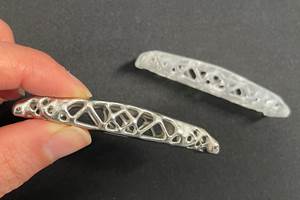What Masking Devices Do I Use?
Types of masking materials to use in plating baths, curing ovens and more...
Ever since I tried to paint both sides of some shelves at the same time, I have never really enjoyed painting. I needed some way to hold the painted object up so I could paint both sides. Painters, platers and processors face this problem every day. One-pass all-side coating is the most efficient process, but cannot be accomplished all the time because of the unusual shapes of objects.
For most applications, the product can be hung from racks, placed in trays or loaded on a conveyor. However, when painting spheres, cylinders, tubes and other unusual shapes, sometimes a more singular solution is required. Expanding a plug into the hole can be the trick that solves two problems. The first and most obvious is that the plug seals the hole, preventing the coating from entering the item and saving coating material. The second feature is that a properly designed plug can be used to hold the coated object from hooks or hangers.
Plating applications face similar problems since there are usually some access or drain holes that must be sealed.
To obtain the proper finish, all plugs and seals need to be compatible with the coating materials. This means the sealing device cannot leach any material into the bath. All seals meant for reuse cannot be destroyed by the process, and, therefore, must be compatible with the temperature and bath.
For painting and coating applications, most reusable sealing devices withstand any commercial paint or powder. However the drying and curing processes require that the rubber sealing portion withstand temperatures in excess of 400°F. In addition, for applications where the seals will be cleaned, it is important that the seal resist acidic cleaners.
For plating applications, the rubber seal needs to be compatible with the applied bath material. Table I presents selections for designing a sealing device compatible with your process.
Table II provides guides that are general recommendations and should be tested prior to starting production. All processes should be tested using disposable samples. The preferred hardware for sealing devices is stainless steel. However, small savings can be realized using zinc-plated steel.
After selecting the proper material, the requirements for a closure mechanism need to be addressed. For pressure seals, a hex nut or handle should be used to ensure adequate closing pressure is applied. For repetitive processes, a snap-action cam can be used to allow quick insertion and removal. The variety of closure styles is unlimited and usually designed right on the plant floor.
When selecting a sealing device, all parameters must be reviewed prior to selecting the material. The best material may not be discovered until after several trials. For example, while silicone is an excellent high-temperature material if used in a threaded hole, it may split frequently. By examining the sealing materials beforehand, one can avoid calamities on the production line. PF
| TABLE I -- Painting and Curing Processes | ||||
| Sealing Material | Max/Min Temp (°F) |
Tear Strength |
Acid Resistance |
Compression Set |
| Neoprene | 250/-65 | Good | Fair | Very Good |
| Silicone | 550/-135 | Poor | Poor | Very Good |
| Buna Nitrile | 300/-75 | Fair | Fair | Very Good |
| Flurosilicone | 550/-90 | Fair | Fair | Very Good |
| EPDM | 300/-60 | Good | Fair | Good |
| TABLE II -- Plating and Coating Processes | ||||
| Plating Material | Recommended Seals | |||
| Buna Nitrile |
EPDM | Flurocarbon (Viton®) |
Neoprene | |
| Chrome - Chromiums Chromic Acid |
Acc | Recd | ||
| Nickel - Boric Acid/ Nickel Chloride or Nickel Sulfamate or Nickel Fluoborate |
Acc | Recd | ||
| Acid Chloride Zinc - Ammonium Chloride or Potassium Cloride |
Acc | Recd | ||
| Alkaline - Non-Cyanide Zinc Zinc Oxide or Sodium Hydroxide |
Recd | Acc | ||
| Cyanide Zinc | Recd | Acc | ||
| Chromic Anodize | Acc | Recd | ||
| Sulfuric Anodize | Recd | Acc | ||
Recd=Recommended
Acc=Acceptable
Viton® is a registered trademark of DuPont Dow Elastomers L.L.C.
Related Content
Possibilities From Electroplating 3D Printed Plastic Parts
Adding layers of nickel or copper to 3D printed polymer can impart desired properties such as electrical conductivity, EMI shielding, abrasion resistance and improved strength — approaching and even exceeding 3D printed metal, according to RePliForm.
Read MoreTroubleshooting Alkaline Zinc
One of the most common problems that can arise when plating with alkaline zinc is an imbalance of brightener in the solution. In this helpful Ask the Expert article, Chad Murphy of Columbia Chemical discusses how different zinc metal concentrations and brightener concentrations can impact efficiency.
Read MoreTrivalent Chrome Overview
As the finishing industry begins to move away from the use of hexavalent chromium to trivalent chromium, what factors should finishers consider as they make new investments? Mark Schario, chief technology officer for Columbia Chemical offers a helpful overview of this complicated topic.
Read MoreProducts Finishing Reveals 2024 Qualifying Top Shops
PF reveals the qualifying shops in its annual Top Shops Benchmarking Survey — a program designed to offer shops insights into their overall performance in the industry.
Read MoreRead Next
A ‘Clean’ Agenda Offers Unique Presentations in Chicago
The 2024 Parts Cleaning Conference, co-located with the International Manufacturing Technology Show, includes presentations by several speakers who are new to the conference and topics that have not been covered in past editions of this event.
Read MoreEpisode 45: An Interview with Chandler Mancuso, MacDermid Envio Solutions
Chandler Mancuso, technical director with MacDermid Envio discusses updating your wastewater treatment system and implementing materials recycling solutions to increase efficiencies, control costs and reduce environmental impact.
Read MoreEducation Bringing Cleaning to Machining
Debuting new speakers and cleaning technology content during this half-day workshop co-located with IMTS 2024.
Read More





















